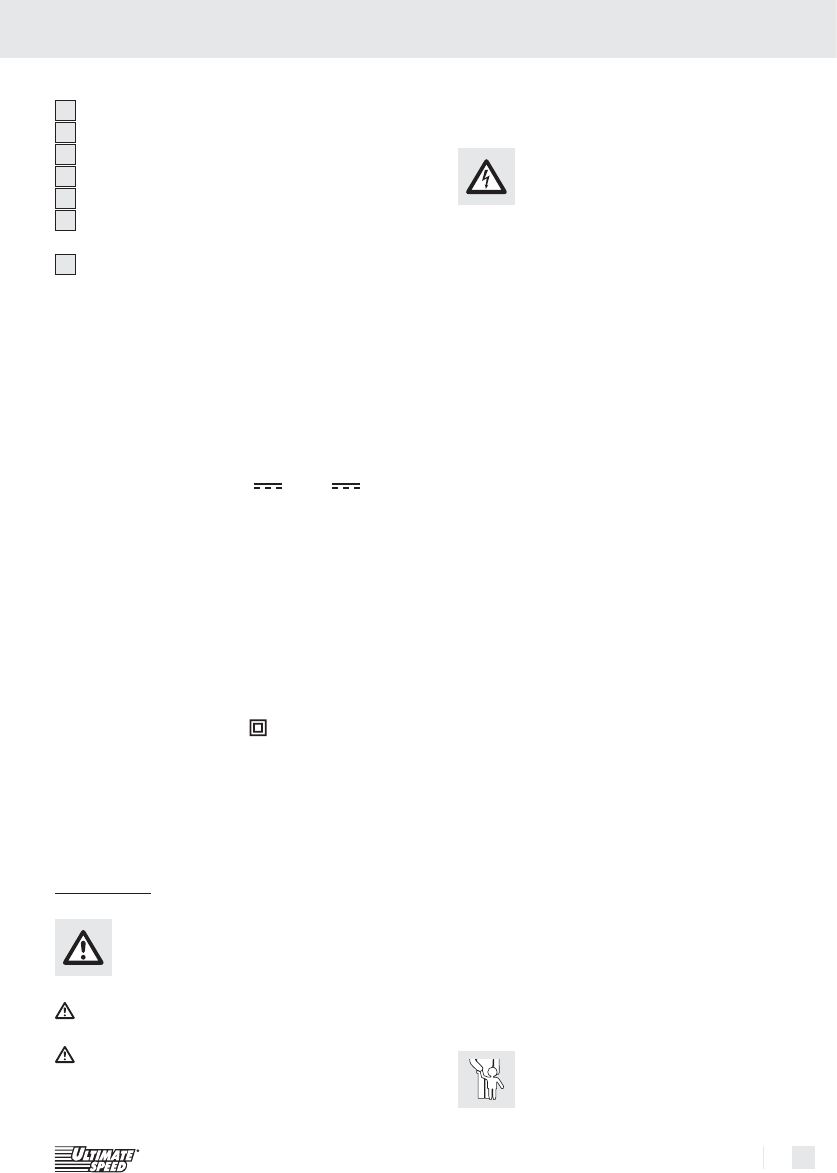
7 GB/IE
Introduction / Safety
see Fig. B:
10
Charging station
11
Mains lead
12
Mounting holes
13
„+“-Pole connection cable (red), incl. ring shoe
14
„–“-Pole connection cable (black), incl. ring shoe
15
„+“-Pole quick-contact terminal (red), incl. red
fixing screw
16
„–“-Pole quick-contact terminal (black), incl.
black fixing screw
©
Technical Data
Input voltage: 220 - 230 - 240 V
~
50 / 60 Hz
Power consumption: 60 W
Reverse current*: < 5 mA (no AC input)
Nominal output voltage: 6 V
/ 12 V
Nominal output current: 0.8 A / 3.8 A
Charging voltage: 7.3 V or 14.4 V or 14.7 V
Charging current: 0.8 A ± 10 %
3.8 A ± 10 %
Battery type: 6 V lead-acid battery
1.2 Ah - 14 Ah
12 V lead-acid battery
1.2 Ah - 120 Ah
Housing protection type: IP 65 (dust-tight, protected
against water jets)
Safety class: II /
* = Return current is the current used by the
charging station battery, when no mains
current is connected.
©
Safety
Safety information
DANGER! Avoid danger to life and limbs
caused by improper use!
CAUTION! Do not operate the appliance
with a damaged cable, power cord or
plug. A damaged power cord causes danger
to life by electric shock.
½ If damaged, have the power cord repaired by
authorised and trained technicians only! Please
contact the service department for your country!
½
PROTECT YOURSELF FROM
AN ELECTRIC SHOCK! When
connecting the charging station, use
a screwdriver and a spanner with an insulated
handle!
½ DANGER OF ELECTRIC SHOCK! Do not
operate the vehicle if you are charging a battery
while it is still in the vehicle! Switch off the igni-
tion and park the vehicle. Apply the parking
brake (e.g. in cars) or secure with a mooring
rope (e.g. electric boat)!
½ DANGER OF ELECTRIC SHOCK! Disconnect
the battery charger from the mains before you
make or break the connections to the battery.
- First connect the clamp that is not connected
to vehicle bodywork, then connect the other
clamp to the vehicle bodywork at a point
away from the battery and the fuel line. After
this is done, you can connect the battery
charger to the mains.
- After charging, disconnect the battery charg-
er from the mains. Then disconnect the clamp
attached to the vehicle bodywork before you
disconnect the clamp from the battery.
½ DANGER OF ELECTRIC SHOCK! Handle
the connecting cables („–“ and „+“) by their
insulated areas only!
½ DANGER OF ELECTRIC SHOCK! Ensure
that there is complete protection from moisture
at the connections to the battery and at the
mains outlet socket!
½ DANGER OF ELECTRIC SHOCK! Carry out
the mounting, maintenance and cleaning of the
battery charger only when it is disconnected
from mains!
½ DANGER OF ELECTRIC SHOCK! After
completion of the charging and maintenance
charging process on a battery mounted in a
vehicle, first disconnect the negative connection
cable (black) of the battery charger from the
negative terminal of the battery.
½
Do not leave small children
unattended with the battery
charger! Children are too young
to assess the possible dangers associated with


















